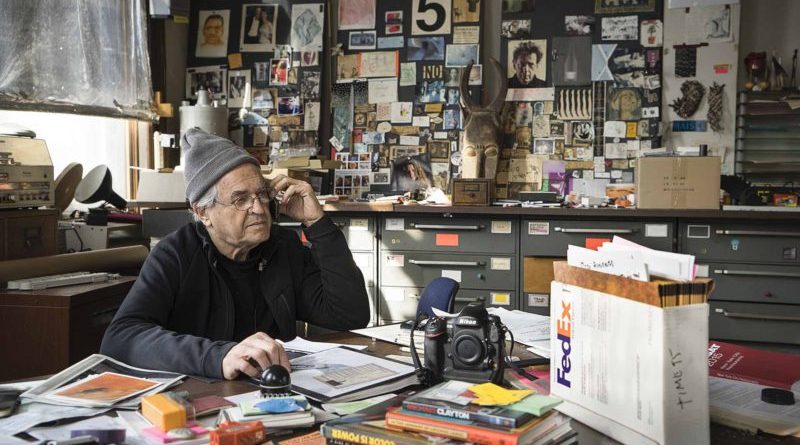REVIEW: ‘Jay Myself’
Photo: Jay Maisel still photographs, but sometimes today he prefers the intimacy of a smartphone camera. Photo courtesy of Oscilloscope Laboratories / Provided by Film Forum press site with permission.
Photographer Jay Maisel has built an impressive career in his chosen trade, with many memorable photographs and assignments over the decades. A few highlights: his photo graced the album cover of Miles Davis’ Kind of Blue, and his images adorned the cover of many publications, including New York magazine.
One of the most important chapter headings in Maisel’s life story is a six-floor, 36,000-square-foot building on Manhattan’s Lower East Side known as “The Bank.” It’s so called because this prime piece of real estate used to be a bank before the neighborhood’s prospects took a gradual decline in the 1960s, which is when Maisel came knocking and used what money he had saved up from his budding photography career to make the purchase. He owned and lived in this massive building, making it the place where he and his wife raised their daughter and the place where he stored many found objects, constantly photographing them and rearranging them.
[Read Hollywood Soapbox’s interview with Jay Maisel here.]
Maisel kept The Bank for several decades, but a few years ago, with the sky-rocketing costs of keeping the property in the now-trendy neighborhood, he had to sell. When he found a buyer for these 72 rooms, Maisel closed on what is believed to be the largest private real-estate sale in the history of New York City up until that point.
Maisel’s final weeks in The Bank are profiled in the new documentary by Stephen Wilkes, Jay Myself, which played the Film Forum in 2019. The portrait is a simultaneous look at Maisel’s life within this iconic building and his views on his work and found objects. What is revealed in these 79 minutes is quite interesting, especially when the camera combs over the convoluted shelves and hallways of the bank building, all of them holding the photographer’s obsessive collecting habits.
Amongst these forgotten treasures — most of them discarded by his fellow New Yorkers — Maisel finds transfixing colors, shapes and depth, and in the film he arranges the thingamajigs in an interesting manner and photographs them from various angles. Other items that don’t catch the attention of his lens simply sit and serve as inspiration; he is clearly surrounded by his muse, which he has full control over, adding to the collection and rarely reducing its size.
There’s an emotional pull in the documentary as well because Maisel is not only leaving his studio behind, but in many ways his identity as well. His wife and daughter lived with him at The Bank, and it was as much a home as it was a place to work. His new digs in Brooklyn are smaller in square footage, so his many found objects are now stored away.
More than anything else, Wilkes tells the story of Manhattan’s Downton by using Maisel as his entry point. In some ways, the film strikes a similar chord to other movies about the Lower East Side, like Streit’s: Matzo and the American Dream and Shadowman. Although one is about a photographer, the other about a longtime Jewish business and the third one about artist Richard Hambleton, each of them tell stories of a similar neighborhood that has changed over the years, encountered gentrification and ultimately seen longtime owners and artists needing to move out. These filmic examples, many of them focused on Manhattan’s changing landscape, are serving as historical snapshots of people, places and communities that are in transition between their homes and their futures.
By John Soltes / Publisher / John@HollywoodSoapbox.com
Jay Myself (2018). Directed by Stephen Wilkes. Featuring Jay Maisel. Running time: 79 minutes. Rating: 




